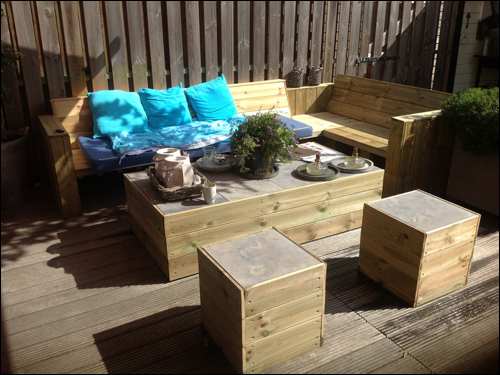Choosing the right decking board for your garden is the key to to setting up a truly elegant area for outdoor living. As a mum, you should know that spending time outside can positively impact your health in many ways. By setting up a decking board in your garden, you can add versatility to the space. You will realise how easy it is to grow plants in areas with limited space by container gardening. The family can also find a place to unwind and relax. This article will assist you in selecting the ideal decking board for your garden. Without further ado, let’s get started.
Factors to consider when choosing the right decking board
To choose the right decking board, you have to first consider your budget. Different materials, like wood, composite, or PVC, come with varying costs upfront and in maintenance over time.
Another vital factor to consider is maintenance. For instance, wood decking requires staining and sealing to prevent rot and decay, while composite and PVC boards need less upkeep. This makes them ideal for busy homeowners.
You should also consider aesthetics and durability. Aesthetics play an important role in enhancing your outdoor area’s appearance. While wood offers a natural, rustic charm, composite and PVC decking provide modern, uniform finishes in various colours and textures.
Durability, on the other hand, is essential for withstanding weather conditions and heavy foot traffic. Here, hardwood decking like ipe or cedar lasts a long time but can be pricey. Composite and PVC decking, though initially costlier, are highly durable and resistant to rot, insects and warping.
Other things to consider include the environmental impact that each deck will have. You can go with sustainably sourced wood, as it ensures the boards are slip-resistant and eco-friendly.
In this article, we will be considering the pros and cons of wood, composite and PVC decking.
Popular Decking Materials
- Wood Decking
- Composite Decking
- PVC Decking
Wood Decking
The general advantages of wood decking are its natural beauty and affordability. The disadvantages include high maintenance (staining, sealing), susceptibility to rot, splintering and fading.
There are different types of wood decking. Cedar, redwood, and pressure-treated are amongst the popular choices, each with pros and cons.
Cedar decking is known for its natural resistance to rot and insects. It’s also lightweight and easy to work with. However, cedar tends to be pricier than other wood and without proper maintenance, its colour can fade over time.
Redwood decking shares similar characteristics with cedar. It boasts rich, attractive colours and a smooth finish. However, like cedar, redwood is relatively expensive, and its availability may be limited in certain regions.
Pressure-treated wood is a budget-friendly option treated with chemicals to resist rot, decay and insect damage. It is quite popular among homeowners on a budget, as it is widely available and easier on the wallet.
However, it requires regular maintenance to preserve its appearance and it may warp or crack over time.
Composite Decking
Composite decking is manufactured from wood plastic composites, a blend of wood fibre and thermoplastic polymers. It has increased in popularity within the last decade, alongside its offshoots, composite fencing and composite cladding.
It combines the regal and elegance appearance of natural wood with the high performance and low maintenance of plastic.
The advantages of composite decking include low maintenance, durability, resistance to rot, splintering and fading, and a wide range of colours and styles. Its disadvantages include higher initial cost, being less natural than wood, and the potential for fading over time.
Composed of a mixture of wood fibres and recycled plastic, composite decking comes in two main parts capped and uncapped.
Capped composite decking features a protective layer that encapsulates the core, providing enhanced durability and resistance to stains, scratches and fading.
This outer layer also makes capped composite decking more resistant to moisture, mould, and mildew. However, capped composite decking tends to be more expensive than uncapped varieties.
Uncapped composite decking, on the other hand, lacks this protective layer, which makes it more susceptible to staining, scratching, and fading over time.
While uncapped composite decking is generally more affordable, it may require more maintenance to preserve its appearance and structural integrity.
Composite decking offers several benefits, including low maintenance, durability, and resistance to rot, insects and warping. However, it can be prone to heat retention, and some varieties may exhibit colour fading over time.
PVC Decking
Advantages of PVC decking include being extremely low to maintain, weather-resistant, durable, and budget-friendly. The disadvantages include – looks and feels less natural, that there are limited colour options, that there is potential heat absorption, and that there are environmental concerns.
PVC decking is made from polyvinyl chloride. Its main advantages include excellent resistance to moisture, mould, mildew and insect damage. It is the ideal choice for areas with high humidity or near water.
PVC decking is highly durable, withstanding scratches, stains, and fading better than many other materials. Continuously, PVC decking requires minimal maintenance, typically only needing occasional cleaning with a deck cleaner.
However, PVC decking can be prone to heat retention. This makes it uncomfortable to walk barefoot in hot weather. It may also have a less natural appearance compared to wood or composite decking.
Although it lacks the wood grain texture, PVC decking tends to be more expensive upfront compared to wood or composite options. Other decking materials, like aluminium and bamboo, offer unique advantages and limitations.
Aluminium decking is exceptionally durable, resistant to rot, insects, and fire, and requires minimal maintenance. However, it can be costly and may need more aesthetic appeal than wood or composite decking.
Bamboo decking is eco-friendly, sustainable, and durable, but it requires regular maintenance to prevent mould and mildew growth.
Making the Right Choice
To choose the right decking board, start by assessing your budget. Consider both upfront costs and long-term maintenance expenses. Next, determine your desired aesthetics, whether you prefer the natural look of wood or the uniform finish of composite or PVC
Consider your DIY skills; some materials may be easier to install than others. Evaluate durability requirements based on your climate and expected foot traffic.
Lastly, factor in maintenance needs and environmental considerations.
You can also improve the beauty and functionality of your decking board by adding decorative elements like
By weighing these factors, you can make an informed decision that best suits your individual needs and priorities.
The importance of choosing the right decking boards cannot be overemphasised. Making the right choice of decking boards allows you to get one that you can afford, that is durable, and that is aesthetically pleasing to the eyes.
It’s okay to contact professionals and further explore resources for personalised guidance.




